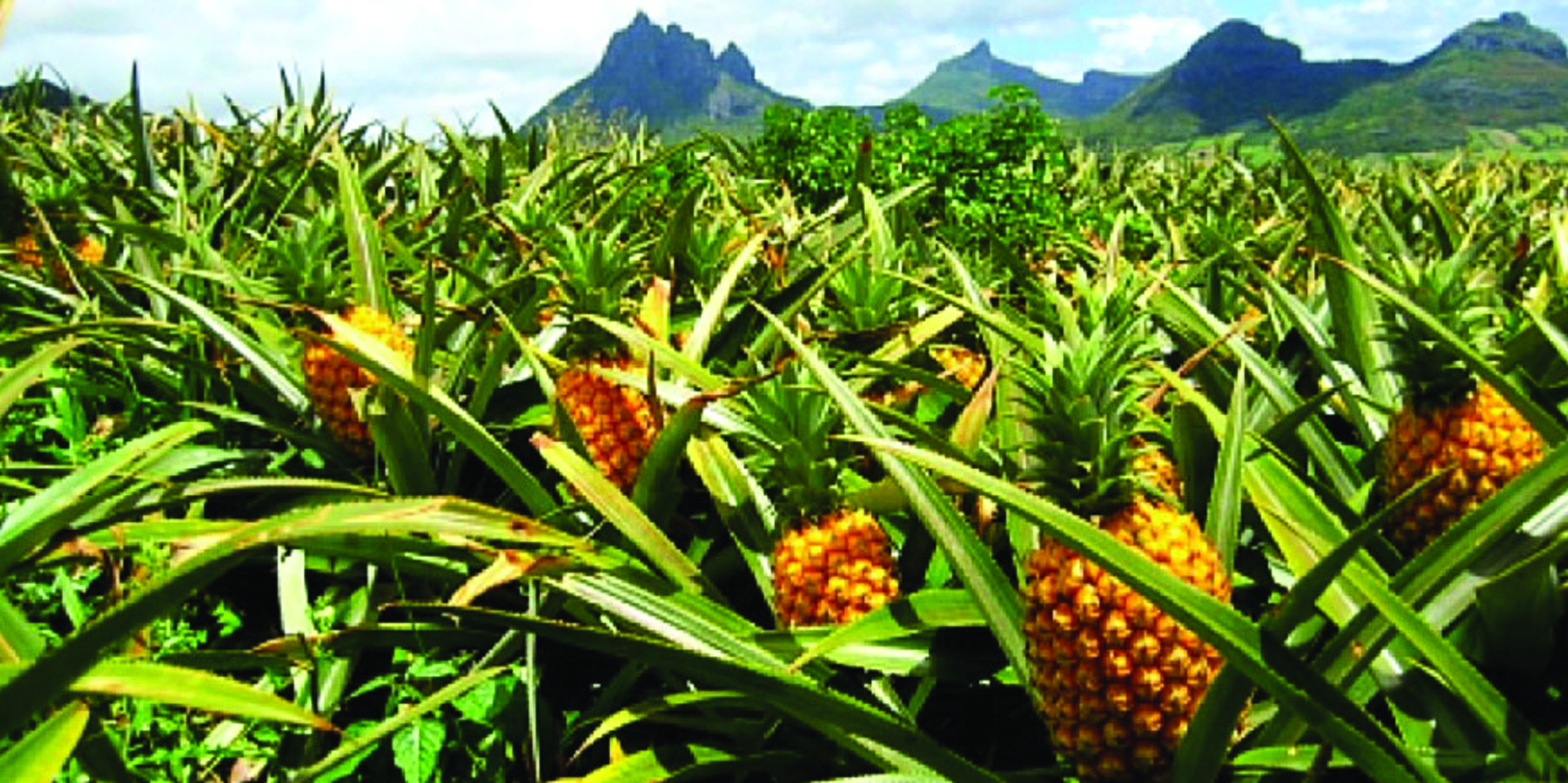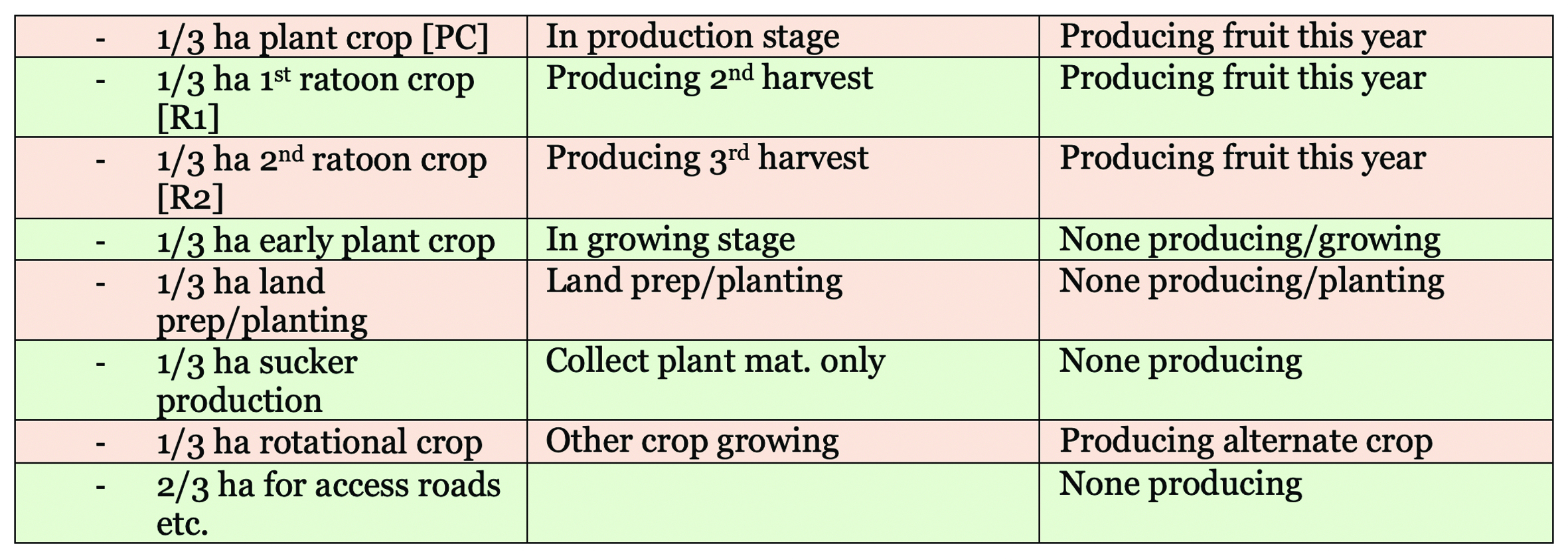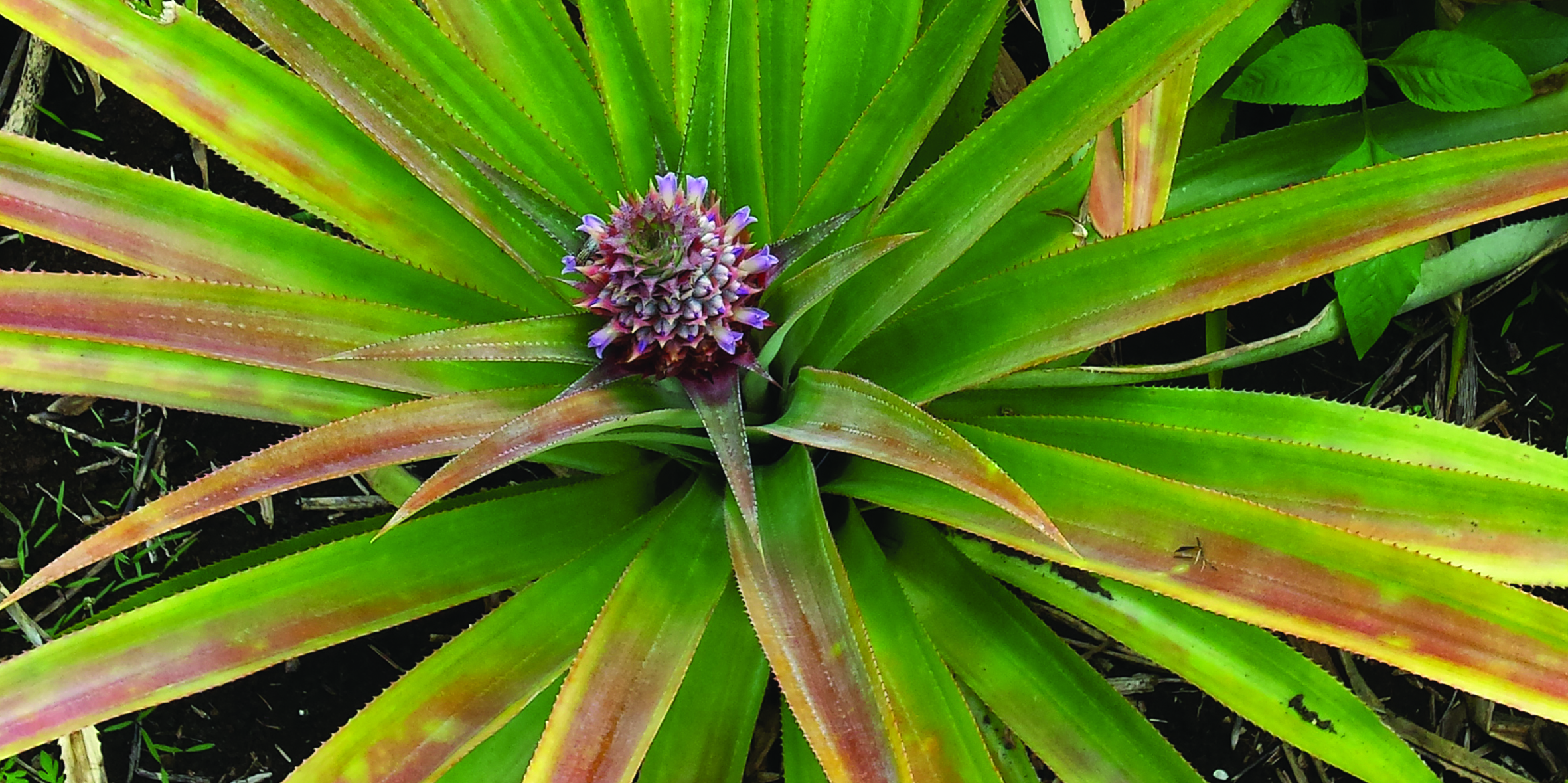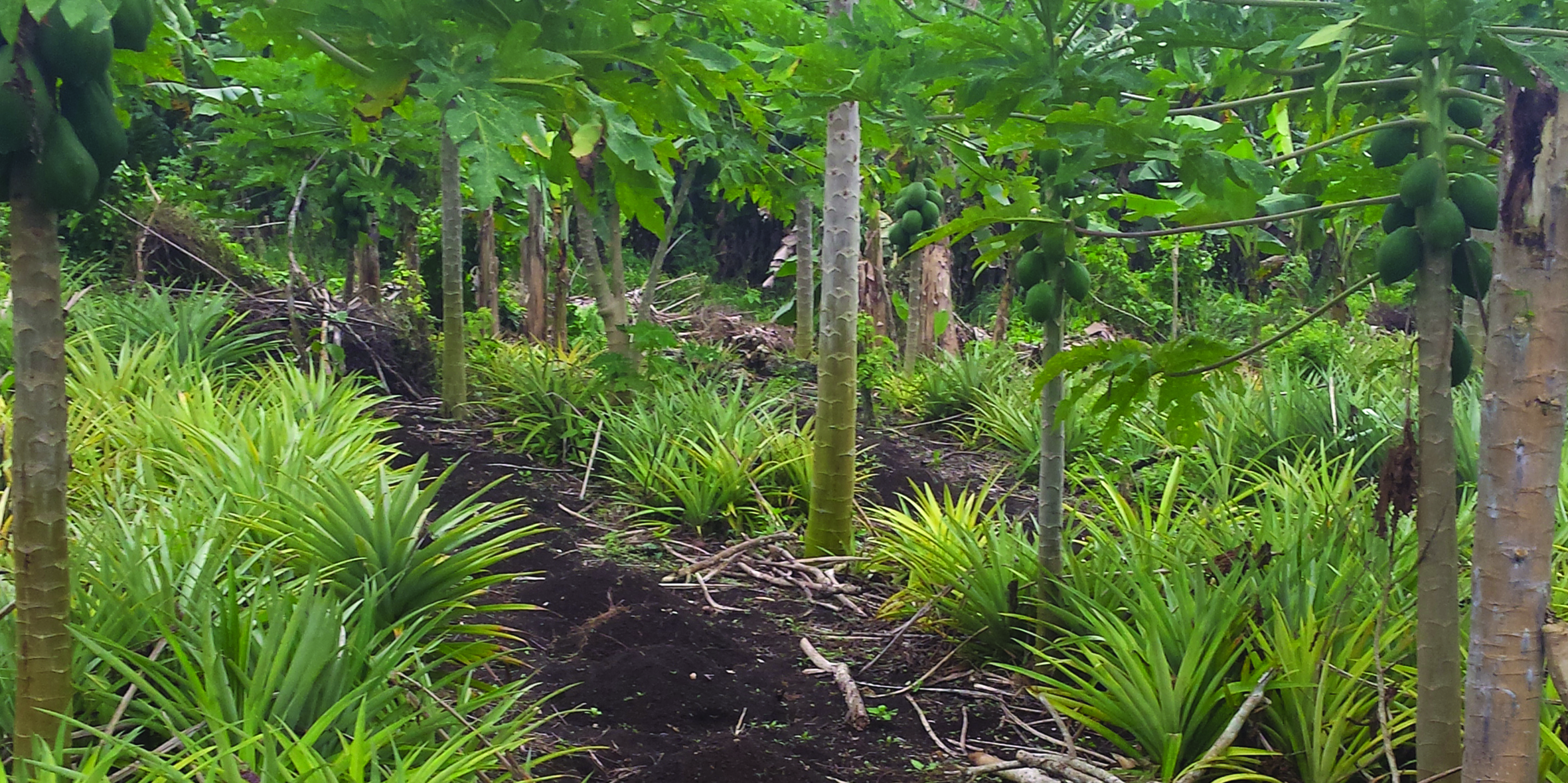b l o g
f e b r u a r y 2 0 2 1

Pineapple can grow where other crops die; planting pineapple on steep slopes must be accompanied with good erosion prevention practices IMAGE: Wonder Gardens
By Aad Van Santen, Lead Author of Pineapple Production In Vanuatu
A farmer may choose to plant 100 or 10,000 plants based on the availability of land, planting material, and the market demands. However, for a consistent supply of year round pineapple it is important to plan out production and land requirements.
To cultivate a pineapple crop with 1 ha under fruit production, assuming 1 plant crop and 2 ratoon crops are planned, an approximate area of 3 ha arable land is needed. This land area is needed for the following reasons;
- From land preparation and planting – to first plant crop harvest will take up to two years when tops and slips are used as planting material,
- Each ratoon crop requires about 1 year development before harvest,
- The old crop (third ratoon) is used for planting material provision and occupies land for 1 year,
- After 4 years growing pineapple plants on the same area a rotation crop is recommended for at least one year, finally access roads are needed for the crop maintenance and harvest operations,
- Finally access roads are needed for the crop maintenance and harvest operations.
The occupied area will thus be divided as follows;

Total 3 ha land
(1 ha pineapple under fruit production at any given time)
Selection Criteria
In choosing the location to grow pineapples the following environmental conditions are to be investigated and considered before making the final decision:
- Climatic conditions such as: temperature, precipitation, irradiation and wind,
- Field conditions such as; topography, soil type and condition, soil fertility and drainage
- Logistical conditions such as; accessibility and road condition, distance to market outlet, and availability of transport.
Temperature
Pineapple is originally a tropically plant. Although it is cultivated over a wide range of climatic conditions, growth below 20o C is reduced, while growth below 10o C will result in no growth or death of the plant. Extended temperatures above 38o C significantly reduce growth or result in death of the plant.
The optimum temperatures for best vegetative (plant size) growing conditions are day temperatures ranging from 28o C to 32o C, and night temperatures ranging from 18o C to 22o C. The temperature variation in and night temperature has a strong effect on the growth rate. When the day/night temperature range is small, such as 29-32o C, growth rates will be reduced. This factor helps to explain why pineapple close to the coast often perform better due to the fact that sea breezes often reduce the night temperatures appreciably, while moderating day time temperatures.
The above explains why Vanuatu (together with the other South Pacific nations in the tropical latitudes) have such optimum growing conditions for pineapple, particularly those farms near the coast.
Precipitation
The pineapple plant has evolved and adapted to flourish in relatively dry environments.
The pineapple is capable of reducing water loss (trans-evaporation) in hot-dry weather, and even able to collect water in their ‘funnel’ like leaves from morning dew in the absence of rainfall. Again, for this reason lower night temperatures will produce more dew that can be collected in the funnel shape pineapple plants.
Although pineapple can endure drought conditions, a minimum of 50mm water per month (rain or irrigated) is needed for limited growth or to maintain the life of the plant. When higher levels of moisture return, increased growth will take place immediately. This may increase the cropping period, but in most cases the plant will survive low rainfall conditions. Optimum growth is obtained when a good supply of water is available (about 100 to 120mm/month).

Funnel shape pineapple plant collects dew and provides moisture to the plant even in times of drought
During the cool-dry season in Vanuatu, rainfall can be very limited in certain areas, but pineapple still can collect a reasonable amount of water from dew, produced when the warm moist air heated by the sun, cools after dark, reducing the amount of moisture the air is capable of holding. Under the right conditions, this moisture alone is capable of sustaining an acceptable amount of plant growth in the absence of rainfall.
Drought resistance and dew collection is strongly dependent on plant. Smaller plants have limited funnel shaped leaves to collect the morning dew. Smaller plants results in less soil cover and a higher soil evaporation rate.
Heavy rainfall presents little risk to the pineapple assuming that land ahs been selected with proper drainage in mind.
Irradiation or Sunshine Intensity
Quality and sweetness (o brix or quantity of sugar) in pineapple is to a large extent dependent on the quantity of sunshine hours and intensity of sunshine. This also explains why at higher latitudes (further from the tropics) the planting density is of greater influence on total yield, because at close planting the pineapple plant does not get optimum radiation or sunshine intensity. However between the tropics (which is where Vanuatu is located for the major part), this problem is not effecting the crop and planting densities up to 55,000 plants/ha will not show lower production because of sunlight (shine) competition nor do lower densities give an increased quantity or quality of fruit per plant.
(Important Note: Plantations in a secondary forest clearing or other potentially shaed area should allow for direct sunlight to all plants for most of the day and throughout the entire year as the path of the sun will change significantly throughout the year.
In terms of irradiation, the tropical islands of Vanuatu are ideally situated for pineapple cropping and can produce top quality fruit
Wind
Most coastal areas have good sea breeze conditions, which favour pineapple growth as earlier mentioned. However these coastal areas are also more prone to heavy wind forces during hurricanes and a lot of taller crops and trees will suffer in those areas considerably more than inland plantations.
But the rather low growing patterns of pineapple makes this crop less susceptible to hurricane damage, especially at high density plantings where plants will support each other. Even the ‘salty’ seawind, which often effects other crops with its high salt content, has shown little problems with pineapple crops except in cases where sea spray comes into direct contact with plants
Topography
When selecting a site for pineapple cropping the typography or field lay-out conditions are an extremely critical consideration. The best topographical conditions for especially mono pineapple cropping are flat to light slopping fields in non-flood prone areas. One these fields continuous blocks of uniform quantities can be planted, and mechanized farming practices are easily performed. In the absence of mechanized farming implements, flat fields are still easier to maintain with reduced labour inputs.

Flat to light sloping lands are ideal for pineapple production – both mechanised and non-mechanise
Not all farming locations have these optimum topographical conditions and often times sloping land is the only option available.
Steeper sloping fields can be used, but since pineapple is only shallow rooted, these steeper slopes will miss the benefit of erosion protection from the deeper rooted grasses and bush normally growing on these slopes.
Steep slopes should be used with care. Slopes with more than 3% gradient will require well designed surface drainage and an erosion protection plan.
On slopes with a gradient >3%, the field rows should run along the contour (horizontal) not sloping downwards more than +2 to maximum 3% with fairly short runs to allow surface drainage of excess rainfall water.
To prevent landslides on steep slopes, frequent drains along the contour are required with ‘down slope’ drains, which have to be erosion protected. Also deep ripping on the steep slopes is to be avoided to prevent the partial soaking of the loose top soil in the field, with landsliding as a possible consequence. Do not use deep ripping on a field with slope gradients of more than 5% (this is not more than a drop of 1 meter over 20 meter distance down the slope) to prevent soil erosion and land sliding during heavy rains.
Areas bordering on long and steeper slopes uphill will normally require large enough header drains to collect the uphill water rainfall and prevent flooding and water erosion in the pineapple fields.
Also avoid fields where rock is surfacing and soil depth is very limited
Soil Type and Conditions
Even though pineapple can principally grow on any soil type that allows enough air around the roots, sandy loam soils with an open soil structure and high humus (organic material) content are best suited for commercial pineapple cropping. An open structure soil is required to allow sufficient air to circulate to the high oxygen consuming roots.
Heavy clay soils with a closed and poor structure are not good for pineapple and these should be avoided if possible. If heavy clay soils must be used, deep ripping and extra organic manure before cultivation could improve these heavier soils greatly through enhancement of the draining capacity and aeration. Heavier loamy clay soils also require extra surface drainage canals to allow abundant rainfall to be quickly removed.
High humus content is profitable for pineapple cropping. These conditions are usually found in heavy busy land and cleared secondary forest, but this heavy busy will require extra work and cost for land clearing.
Soil Fertility
Since pineapple is capable of absorbing nutrients through the aerial parts of the plant, there is no immediate dependency on the fertility of the soil. Although it is not ideal, poor fertility soils can be used for pineapple cropping. In the case of poor fertile soils the farmer must plan to apply fertilizer such as a pre-planting organic manure. Post-planting will require additional concentrated fertilizer for maximum growth and quality of fruit. Even in high fertile soils, it should be remembered that the nutrients removed by the crop are to be replaced by fertilization if the fertility level and value of the soil and land is to be maintained.
On poor soils, addition of humus is beneficial for optimum pineapple growth.
During land clearing, avoid the scraping of the soil in an effort to level the field. This top soil is the highest in nutrient value and humus content.
Soil Depth
Rooting depth of pineapple ranges from 15-30cm for the largest portion of the root mass, but depth of soil should reach at least 500m.
Drainage Conditions
Pineapple roots require oxygen provided by accessible air. These roots, if deprived of oxygen, will not do well for even a short period of time. Poor drainage and water logged soil prevents air from reaching the roots.
The field should be drained to at least a depth of 1-1.5m and not subject to flooding during the rainy season. A few hours of water logging can do a significant amount of damage to the roots. Do not plant in places that already act as natural drains. Even with provision of man-made drains it is very hard to change natural draining courses and flooding is likely to occur in these places during heavy rain.
Fields at the bottom of valleys or flats near creek and river banks are also to be avoided unless proper drainage can be engineered at both low water and high water. Underground water tables may be reaching the plant roots without being visible on the surface.
Site Selection Summary
An ideal pineapple site has an abundance of sunshine, sufficient drainage, slight to moderate sloping land, and a soil mixture that contains a sufficient amount of organic matter.
Next: Land Preparation
